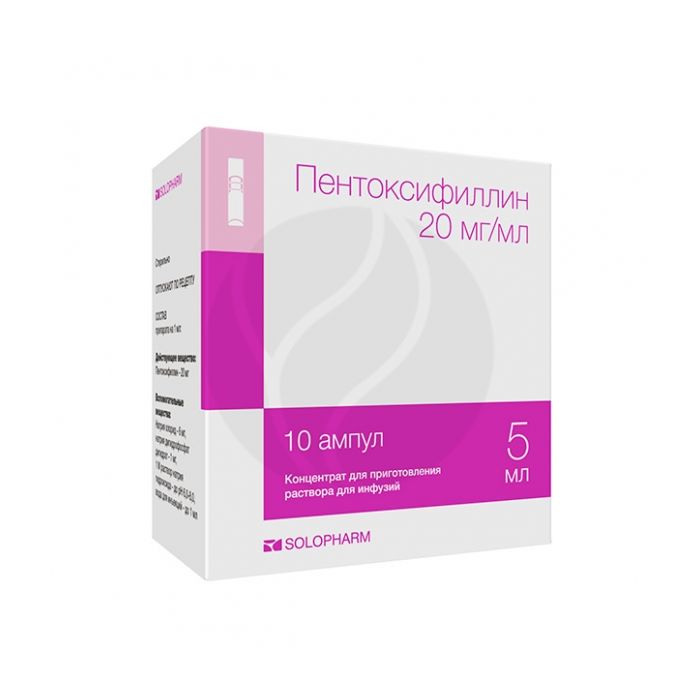Pentoxifylline injection solution 2%, 5 ml No. 10 Solofarm
Expiration Date: 05/2027
Russian Pharmacy name:
Пентоксифиллин раствор для инъекций 2%, 5 мл №10 Солофарм
Apply i / a (jet or drip), i / v (jet or drip), i / m, inside. The dose and treatment regimen are set individually.
active substance: pentoxifylline
Acute myocardial infarction, porphyria, massive bleeding, hemorrhagic stroke, retinal hemorrhage, pregnancy, lactation. For intravenous administration (additionally) - arrhythmias, severe atherosclerosis of the coronary or cerebral arteries, uncontrolled arterial hypotension, hypersensitivity to pentoxifylline and other xanthine derivatives.
pharmachologic effect
An agent that improves microcirculation, an angioprotector, a dimethylxanthine derivative. Pentoxifylline reduces blood viscosity, causes platelet disaggregation, increases the elasticity of red blood cells (by affecting the pathologically altered deformability of red blood cells), improves microcirculation and increases the oxygen concentration in tissues. Increases the concentration of cAMP in platelets and ATP in erythrocytes with simultaneous saturation of the energy potential, which in turn leads to vasodilation, a decrease in systemic vascular resistance, an increase in stroke volume and minute blood volume without significant changes in heart rate. By expanding the coronary arteries, it increases the delivery of oxygen to the myocardium, dilating the vessels of the lungs, and improving blood oxygenation. Increases the tone of the respiratory muscles (intercostal muscles and diaphragm). IV introduction, along with the above action,leads to an increase in collateral blood circulation, an increase in the volume of blood flowing through the unit of the section. Increases the concentration of ATP in the brain, has a beneficial effect on the bioelectrical activity of the central nervous system. Improves microcirculation in areas of impaired blood supply. With occlusive lesion of the peripheral arteries (intermittent claudication) leads to an increase in walking distance, elimination of nocturnal calf muscle cramps and pain at rest.elimination of night cramps of the calf muscles and pain at rest.elimination of night cramps of the calf muscles and pain at rest.
Pharmacokinetics
After oral administration, it is well absorbed from the gastrointestinal tract. There is little metabolism on the 'first pass' through the liver. Binds to erythrocyte membranes. It undergoes biotransformation, first in erythrocytes, then in the liver. Some metabolites are active. T1 / 2 from the plasma of unchanged substance is 0.4-0.8 hours, metabolites - 1-1.6 hours. After 24 hours, most of the dose is excreted in the urine in the form of metabolites, a smaller part (about 4%) through the intestines. Excretion of pentoxifylline is reduced in elderly patients and with liver diseases.
Side effect
From the side of the central nervous system: headache, dizziness; anxiety, sleep disturbances, convulsions. Dermatological reactions: flushing of the skin of the face, 'hot flushes' of blood to the skin of the face and upper part of the chest, edema, increased fragility of the nails. From the digestive system: dry mouth, decreased appetite, intestinal atony, exacerbation of cholecystitis, cholestatic hepatitis, increased activity of hepatic transaminases and alkaline phosphatase. From the side of the organ of vision: visual impairment, scotoma. From the side of the cardiovascular system: tachycardia, arrhythmia, cardialgia, progression of angina pectoris, lowering blood pressure. From the hematopoietic system: thrombocytopenia, leukopenia, pancytopenia. From the side of the blood coagulation system: hypofibrinogenemia, bleeding from blood vessels of the skin, mucous membranes, stomach, intestines. Allergic reactions: itching, flushing of the skin, urticaria,angioedema, anaphylactic shock.
Application during pregnancy and lactation
Adequate and well-controlled clinical studies of the safety of pentoxifylline use during pregnancy have not been conducted. Pentoxifylline and its metabolites are excreted in breast milk. If necessary, use during lactation should stop breastfeeding.
Application for violations of liver function
In severe liver dysfunction, correction of the pentoxifylline dosage regimen is required.
Application for impaired renal function
In case of impaired renal function, correction of the pentoxifylline dosage regimen is required.
Application in children
Use with caution in children and adolescents under the age of 18 (efficacy and safety have not been studied).
special instructions
Use with caution in case of BP lability (tendency to arterial hypotension), chronic heart failure, gastric ulcer and duodenal ulcer (for oral administration), after recent surgical interventions, with hepatic and / or renal failure, in children and adolescents under the age of 18 years old (efficacy and safety have not been studied). In case of impaired renal function or severely impaired liver function, correction of the pentoxifylline dosage regimen is required. During the treatment period, the blood pressure level should be monitored. With simultaneous use with antihypertensive drugs, insulin, oral hypoglycemic drugs, it may be necessary to reduce the dose of pentoxifylline. With simultaneous use with anticoagulants, blood coagulation indicators should be carefully monitored.
Drug interactions
Pentoxifylline can potentiate the action of antihypertensive drugs. Against the background of parenteral use of pentoxifylline in high doses, it is possible to increase the hypoglycemic effect of insulin in patients with diabetes mellitus. With simultaneous use with ketorolac, an increase in the risk of bleeding and / or an increase in prothrombin time is possible; with meloxicam - increased risk of bleeding; with sympatholytics, ganglion blockers and vasodilators - a decrease in blood pressure is possible; with heparin, fibrinolytic drugs - an increase in the anticoagulant effect. Cimetidine significantly increases the concentration of pentoxifylline in the blood plasma, therefore, with simultaneous use, the likelihood of side effects may increase.

